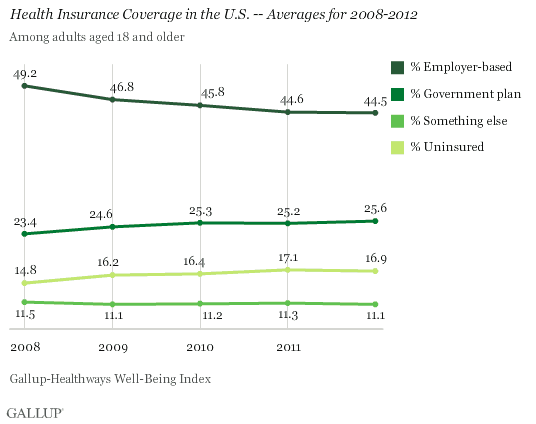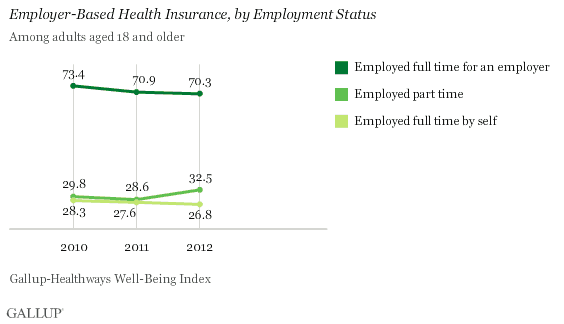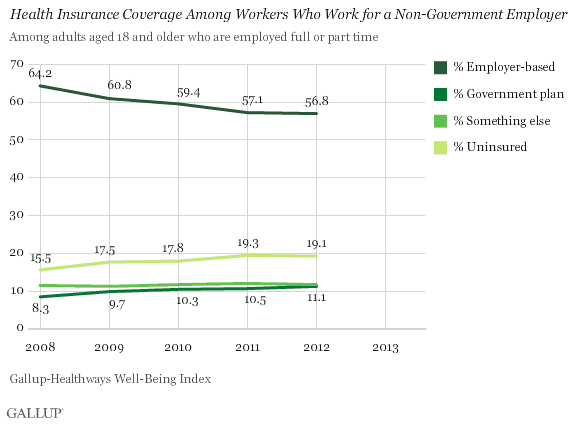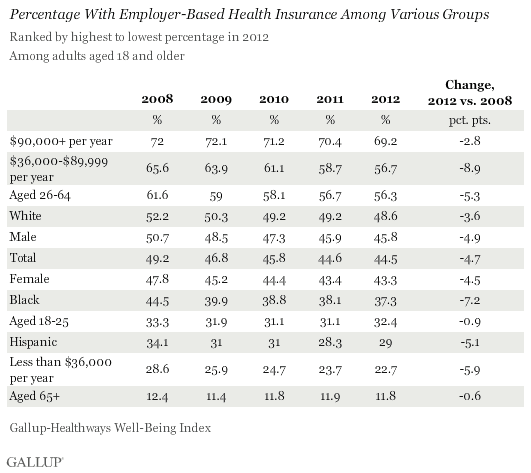WASHINGTON, D.C. -- Fewer Americans reported having employer-based health insurance in 2012 than did in 2008, 2009, and 2010, but at 44.5% it is unchanged from 2011. At the same time, more Americans continue to report having a government-based health plan -- Medicare, Medicaid, or military or veterans' benefits -- with the 25.6% who did so in 2012 up from 23.4% in 2008.

The percentage of Americans who say they get their coverage through "something else," which could mean they buy it for themselves, has been relatively unchanged over the years. Importantly, while more Americans remain uninsured than in the past, the percentage who are uninsured decreased slightly in 2012, after having risen each year previously going back to 2009.
High unemployment is partly to blame for the decrease in employer-based health insurance. The decline may also be due to fewer employers offering insurance or due to employees opting to not take their employers' plan due to rising health insurance costs for employees.
The decline in employer-based coverage is apparent for those workers employed full time for an employer or for themselves. However, the percentage of part-time workers who have employer-based insurance rose in 2012. This group of workers skews young, and young adults -- many of whom are either likely still in college and thus can only work part time or are just entering the workforce and struggling to find a job -- have become more likely to be insured since the healthcare law provision allowing those up to age 26 to stay on their parents' plans went into effect.

The majority of workers who do not have a government job continue to get their health insurance from their employer. But the 56.8% who did so in 2012 is down from a high of 64.2% in 2008. More non-government workers now get their insurance from a government plan or are uninsured than were in 2008.

Employer-Based Insurance Rates Vary by Income, Race, and Age
High-income Americans are the most likely to get their health insurance from an employer, while low-income Americans are among the least likely -- 69.2% vs. 22.7%. Americans in all income groups, however, are less likely now than in 2008 to have employer-based healthcare coverage.
Employer-based health insurance coverage rates have dropped among all major subgroups since 2008, declining the most for middle-income Americans and the least for seniors. Rates have, in fact, been steadily trending down every year since 2008.

Over the past year, young adults aged 18 to 25 are the only subgroup to register a significant increase in employer-based insurance, likely because those in this age group are now eligible to stay on their parents' plans due to the Affordable Care Act.
Bottom Line
Fewer Americans continue to have employer-based insurance than did so in 2008. This appears to be due to two factors: higher unemployment and fewer workers getting insurance through an employer, either because that employer no longer offers it or because the cost is prohibitive for the employee. Americans are now more likely to be uninsured or to get their coverage through a government-based program.
Beginning in 2014, under the Affordable Care Act, large employers will be required to pay a fee -- called an "assessment" -- if they do not provide adequate insurance coverage and their employees receive tax credits to buy their own insurance. Whether this creates an incentive for employers to provide affordable coverage, or whether they will simply pay the penalty remains unclear, thus the future direction of the employer-based insurance rates in the U.S. is yet to be determined.
The new law also expands the Medicaid program in 2014 to cover more people, which will likely affect the total percentage of all adults who get their coverage through a government plan. The combined changes the law will bring about, including the opening of health insurance marketplaces and the individual mandate, will certainly shift the breakdown of where Americans get their insurance.
About the Gallup-Healthways Well-Being Index
The Gallup-Healthways Well-Being Index tracks well-being in the U.S. and provides best-in-class solutions for a healthier world. To learn more, please visit well-beingindex.com.
Survey Methods
Results are based on telephone interviews conducted as part of the Gallup-Healthways Well-Being Index survey Jan. 1-Dec. 31, 2012, with a random sample of 353,563 adults, aged 18 and older, living in all 50 U.S. states and the District of Columbia, selected using random-digit-dial sampling.
For results based on the total sample of national adults, one can say with 95% confidence that the maximum margin of sampling error is ±0.2 percentage point.
For results based on subgroups, one can say with 95% confidence that the maximum margin of sampling error is ±1 percentage point.
Interviews are conducted with respondents on landline telephones and cellular phones, with interviews conducted in Spanish for respondents who are primarily Spanish-speaking. Each sample includes a minimum quota of 400 cellphone respondents and 600 landline respondents per 1,000 national adults, with additional minimum quotas among landline respondents by region. Landline telephone numbers are chosen at random among listed telephone numbers. Cellphone numbers are selected using random-digit-dial methods. Landline respondents are chosen at random within each household on the basis of which member had the most recent birthday.
Samples are weighted by gender, age, race, Hispanic ethnicity, education, region, adults in the household, and phone status (cell phone only/landline only/both, cell phone mostly, and having an unlisted landline number). Demographic weighting targets are based on the March 2011 Current Population Survey figures for the aged 18 and older non-institutionalized population living in U.S. telephone households. All reported margins of sampling error include the computed design effects for weighting and sample design.
In addition to sampling error, question wording and practical difficulties in conducting surveys can introduce error or bias into the findings of public opinion polls.
For more details on Gallup's polling methodology, visit https://www.gallup.com/.
